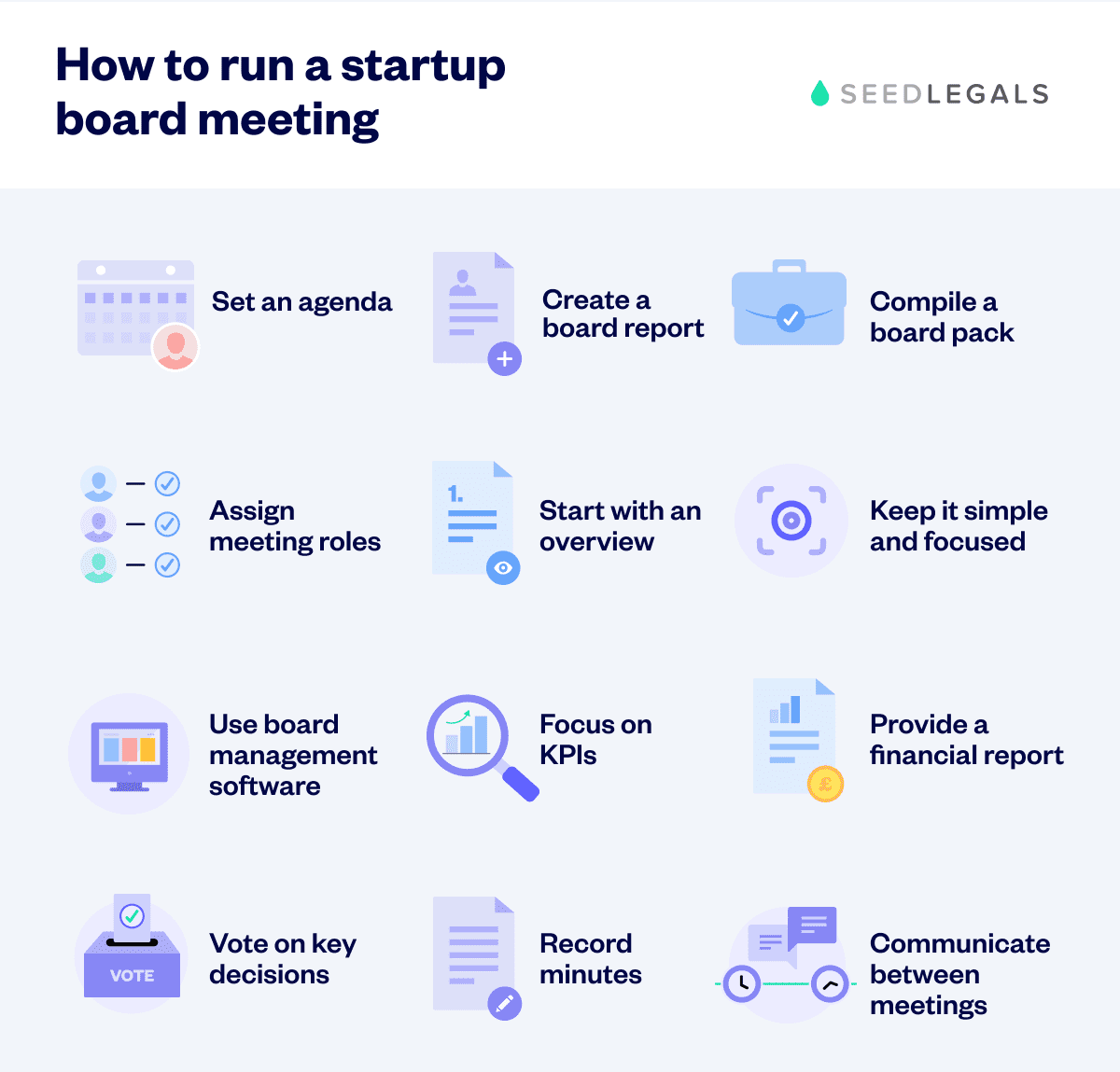Board meetings: what they are and when to hold them
We explain your obligations, who to invite, what to discuss and how to make the most of board meetings to review progres...
Board meetings don’t have to be lengthy, stressful or boring. They should and can be efficient, focused and useful. That’s why we’ve put together this guidance to help you keep your startup board meetings productive.
In the article:
A startup board meeting is a formal gathering of key stakeholders, including founders, executive directors (such as your CTO and CFO, if you have them), non-executive directors and investors (if they have a board seat), to discuss and review the company’s:
🗺️strategic direction
📈performance
📌market positioning
👩💻product development
😬potential risks
🪴overall health
Startup board meetings are essential to create transparency, accountability, and alignment among all stakeholders. They help your board to navigate challenges, capitalise on opportunities and drive sustainable growth.
It’s up to you how often you hold board meetings. You can (and probably will) hold informal board meetings regularly, even once a week, in the early stages. It can be a good idea to hold formal board meetings once a month during these early stages too.
When you’re in a good rhythm and your company is growing, a quarterly board meeting is usually enough.
Use the guidance below to get the most out of your board meetings.
Create an agenda for your meeting so that everyone knows what to expect. You can also set out how many minutes you’d like to spend on each topic.
Make sure that for each agenda point, you discuss the essentials and don’t waste time updating people on what they already know. Send the agenda out with the invitation for the board meeting and include it in your board pack.
A board report is a document that gives details on the upcoming board meeting and should be shared with board members before the meeting. A board report should include:
📊KPI (key performance indicator) overviews
📈company financials
🗺️business strategy
🌱growth projections
🗣️key themes to discuss
A board report gives an overview of how the company is performing and what needs to be discussed at the next board meeting. It should be concise, easy to read and engaging.
Give your board report a table of contents, and make it easy to read by separating the key themes into clear section headings. Provide the essential information in bullet points under each heading and use visuals (such as graphs and timelines) to support information where you can.
Send the report to board members a few days in advance of the meeting so that everyone has a chance to read it and can come prepared. You’ll get the most value out of your board members if they’ve had a few days to process and come up with ways to help.
Share a financial statement with its current balance and profit and loss for the period since the last board meeting.
You can include the financial statement in your board report, and make it an item to be discussed on the agenda. Staying up to date with exactly where the business stands financially is essential for all company stakeholders, especially directors.
A board pack is a compilation of all the meeting materials a board member receives in advance of the board meeting.
A board pack typically includes:
📄agenda
📑minutes from the last board meeting
💻presentation decks
🗂️board report (including financial report)
🤚board resolutions up for debate
✍️pending action items
Send the board pack out with the board meeting invitation.
So, who’s doing what? That’s an important question to answer if you want things to run smoothly.
Make sure you assign a chair (the person who will run the meeting) and someone to take minutes. You should also ensure well in advance that anyone who needs to give an update or presentation is prepared to do so and that it’s noted in the agenda.
Begin your board meeting with a brief overview of:
Follow up with people who had to take on certain tasks after the last board meeting. You can either follow up before the meeting and include their updates in the overview at the beginning of the meeting; or if their update relates to an item on the agenda they can give it briefly when you come to that agenda item.
In the meeting minutes, record what needs to be followed up on in the overview for the next board meeting.
Make sure all the materials you provide (agenda, board report, presentations) are clear and succinct. Board members will have different areas of expertise and will need to get up to speed with topics that they’re not familiar with, so keep that in mind and make sure everybody at the meeting has the opportunity to understand what’s being discussed.
Try not to veer off topic – the chair should keep everyone focused on the agenda and move the meeting forward.
Every company needs KPIs to monitor progress and stay on track with its strategy and growth.
You should discuss KPIs at each board meeting so that everybody understands how the company is performing and what adjustments need to be made. Include an overview of KPIs in your board report and make it an important point on the agenda.
If there’s a decision that needs to be agreed on by your board, it must be done at a formal board meeting. All board members must vote on the decision and there must be a majority vote for a decision to be agreed upon.
After board members vote to pass the decision or not, the result is recorded in your board minutes as a board resolution.
It’s a legal requirement to take minutes at your board meeting. The Companies Act states that a company must record minutes at all meetings of its directors (source: legislation.gov.uk).
Taking board minutes can also be a useful tool to:
Before you end your board meeting, briefly discuss:
Board meetings should not be the only forum in which to discuss major issues. If there is a problem that affects board members and important stakeholders, communicate these in real-time so members can take more immediate action.
You can also make your board feel more in the loop by adding them to your company newsletters and marketing mailing lists.
Automate where you can by using software that can make it faster and easier to create, share and store your agenda and meeting minutes. If you can save time, improve organisation and eliminate human error, you’ll free up headspace for the important stuff.




Our board management software automates the admin of board meetings and board management.








